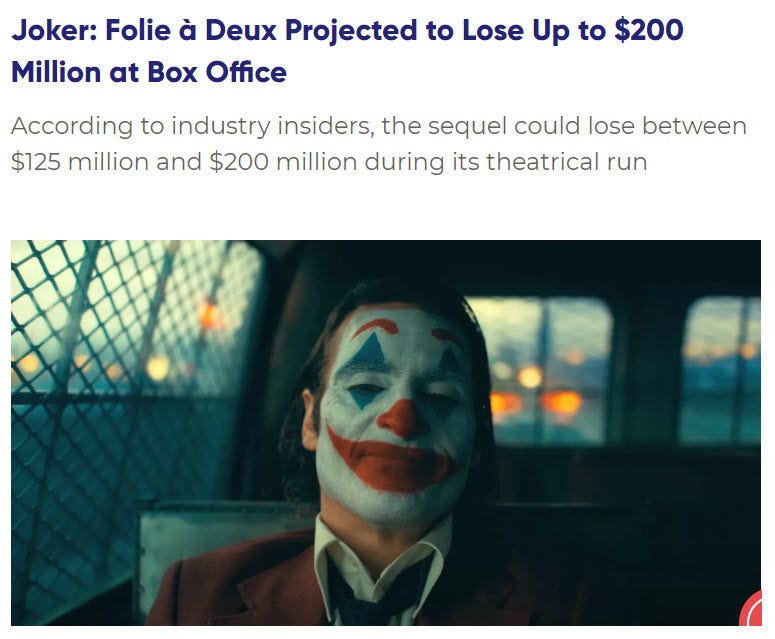No Joke: Product Teams Don't Appreciate (or Practice) Agile Like They Should
Learning that the new "Joker" movie might lose hundreds of millions reminded me of how good we have it in Tech.
If you’ve read this blog over the past year, you’ve been subjected to more than a few articles swimming in cynicism. Tech’s been tough this year. But today? I realized it isn’t all bad and technology teams have a major advantage over other industries. Speaking for myself - I overlook this all the time.
This morning I read that the new movie “Joker: Folie à Deux” could lose up to $200M due to poor box office performance. How could this be? The film is a sequel to a huge hit. The film includes two of today’s largest superstars in Joaquin Phoenix and Lady Gaga. The characters and storyline are spawned from the superhero universe which typically guarantees success. Yet, poor reviews lead to poor box office turnout and eventually the film can’t catch up to its giant budget.
So, what does this have to do with Tech? Risk mitigation. When we’re building a new product or feature, we have this amazing tool at our disposal: Prototypes. We can throw this in front of customers, get feedback, and then take action. The best part? This tool can be leveraged multiple times (even with the same customer) with the only real expense being time. We have the luxury of reading the pulse of our customers while we make the thing that they want.
Now, imagine if Todd Phillips (the writer, director and producer of the “Joker” sequel) brought his customers through the making of his movie? You’d get mixed results, you’d get leaks of the plot and you’d only add to the enormous budget if you were forced to rewrite the script, etc.
For movie makers - similar to a lot of art - you are forced to go “all in”. In the world of project methodology, this would be labeled “waterfall”, or building a product in one shot, covering all requirements before delivering the product to its intended audience. While necessary - or even preferred - in some industries, waterfall is risk laden whenever there’s uncertainty in audience reception. Waterfall tends to work better when the final output has been clearly agreed upon by the client and customer.
The Batman to waterfall’s Joker is “agile”. Agile methodology has many virtues and perhaps at the top of that list is risk mitigation. By checking in with the customer throughout the development of the product, success is defined and redefined to increase the probability that the final result is viable.
In my career, I’ve practiced both styles. When I started my career in classical project management, waterfall was the default mode. However, as I transitioned to Product Management, teams I had been part of did come across projects where there wasn’t much question what the result would be. For example, we needed to increase performance of one of our core services once. We had tested one data management system for performance and then decided to move forward and swap out our old system. We’d meet everyday, plan sprints, groom tickets and have retrospectives to talk about the previous two weeks. Most of these meetings were dull and predictable. Eventually, I asked the team if we should just do waterfall. The team was paralyzed by my question at first but as we discussed it, we realized it would save time and get us to the finish line faster. The project went great and customers loved the results.
However, the vast majority of initiatives I’ve been part of have been classic agile. I’ve seen one large differentiator between teams that do agile well and those that don’t. The best teams truly do include the customer. As product evolves, the team frequently engages with the customer to gauge their reaction. Conversely, some teams don’t do this. It’s not because they don’t want to. It’s because it’s really freaking hard. Organizing the customer interviews, fostering client relationships, setting up the framework for feedback takes time and effort.
Agile - when done well - gives Product teams a tremendous advantage. Sure, we may not be producing blockbuster movies, but - with some effort - we can produce a Hollywood happy ending to our own story.


